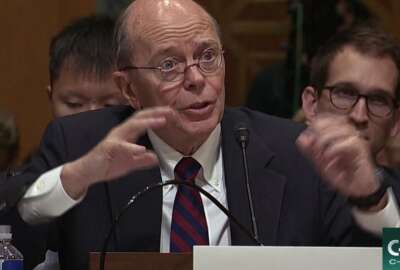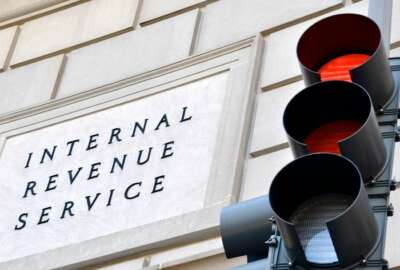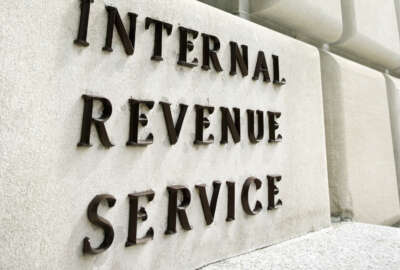

Despite years of shrinking budgets and a smaller workforce, the Government Accountability Office gave the IRS a thumbs up for this year's tax filing season.
Despite years of shrinking budgets and a smaller workforce — as well as a Tax Day computer system glitch that sowed confusion among those submitting last-minute returns — the IRS got a thumbs-up from the Government Accountability Office for this year’s tax filing season.
“Overall, despite multiple challenges including mid-filing season changes to tax law and a
computer system failure, IRS met its processing targets for individual tax returns,” GAO wrote in a report Monday.
The April 17 outage affected the IRS’ Direct Pay system, which the agency uses to collect payment from taxpayers who owe money on their income taxes. However, taxpayers were still able to prepare and submit their tax returns online.
Amid the confusion, the agency gave taxpayers an extra day to send in their returns. GAO and the IRS found that the glitch had nothing to do with the agency’s aging IT infrastructure.
“IRS officials said the problem was caused by a hardware issue in a 1.5-year-old mainframe subcomponent and was not related to IRS applications or any of the agency’s legacy computer systems,” GAO wrote. “Neither the system issue nor the later start had a significant effect on returns processing during the filing season.”
By April 20, the IRS processed 130.48 million returns, compared to 128.85 million returns it had completed in the same time in 2017.
The agency fielded all of this work despite years of diminishing resources. Between fiscal 2013 and 2018, the IRS’ budget fell by about $658 million, or more than 5 percent.
President Donald Trump 2019 budget plan would further cut the IRS’ current budget of $11.4 billion to $11.1 billion.
“This amount is less than the fiscal year 2000 level for IRS, after adjusting for inflation,” GAO wrote about the president’s budget request.
In order to implement the tax reform law that passed last year, the IRS will need to upgrade more than 140 computer systems and update more than 450 tax forms by next year’s filing season.
In order to coordinate the work for the upcoming filing season, the IRS established a centralized office to keep agency program offices in the loop.
“IRS officials cited the broad scope and complexity of the changes — which will require extensive changes to tax forms, publications, and computer systems — along with the one-year time frame as key implementation challenges,” GAO wrote.
However, GAO found that the new coordination office didn’t “fully include” the Human Capital Office (HCO).
“Representatives from HCO now attend weekly coordination meetings discussing and planning the tax law changes. Involving HCO in these discussions will better position IRS to hire new employees and train them and the existing workforce,” GAO wrote. “It will also help HCO better understand training requirements and staffing needs ahead of the 2019 filing season.”
For the third year in a row, the IRS improved its over-the-phone customer service, answering 80 percent of calls for tax help and reducing wait times to approximately five minutes.
That, GAO said, is a huge improvement, compared to the 37.5 percent call answering rate and 23 minute average wait time during the 2015 tax filing season.
“The Internal Revenue Service generally improved its customer service during the 2018 filing season compared to prior years and managed multiple return processing challenges,” GAO wrote.
In June, the IRS upgraded the 15-year-old system used to answer taxpayer calls after complaints of poor connectivity.
“At times the assistor could hear the customer speaking, but the customer could not
hear the assistor. The new equipment will enable future service improvements such as a call-back feature so customers will not have to wait on the line for a response,” GAO wrote.
While the IRS has gotten a handle on its phone service, the agency receives substantially fewer falls than it used to. GAO found call volumes decreased by about 43 percent since 2013.
IRS officials explained the drop in calls on a “targeted media campaign” to ensure taxpayers had all the information they needed before the filing deadline, and fewer people redialing the call centers after long wait times.
Between 2013 and 2018, the IRS received about 107 million calls every year. Some of those callers have also taken advantage of the agency’s expanded online customer service.
“Taxpayer use of online services also increased, including irs.gov and its online account tool for taxpayers to view their balances due,” GAO wrote.
However, the agency still faces some hurdles with more traditional forms of communication, like taxpayers who write letters to the agency asking for tax help.
“Because the same staff answer telephone calls and respond to correspondence, IRS has continued to struggle to balance competing demands for maintaining quality telephone level of service with timely responses to written correspondence,” GAO wrote.
While the IRS seeks to answer mail within 45 days, it was late responding to 37 percent of its correspondence in 2018, compared to 26 percent in 2017.
Visits to the IRS’ Taxpayer Assistance Centers have also decreased since the agency required visitors to schedule appointments in 2016 — from 1.3 million visits in 2017 to 1 million visits in 2018.
“However, IRS officials reported that, between January 1 and April 30, 2018, over half of the
approximately 1.6 million taxpayers requesting an appointment had their questions resolved on the telephone and did not need an appointment,” GAO wrote.
The Senate on Wednesday confirmed Beverly Hills-based tax attorney Charles Rettig as President Donald Trump’s permanent pick to serve as IRS commissioner.
Rettig, approved for the job by a 64-33 vote, will serve as commissioner until November 2022. He’ll take over for David Kautter, who’s held the role since November 2017.
At a Senate Finance Committee hearing in June, Rettig told lawmakers he’d make IT modernization a top priority, and said he’d seek critical hiring authority — as his predecessor did — to attract top talent to hard-to-fill IT jobs at the agency.
Tony Reardon, president of the National Treasury Employees Union, congratulated Rettig on his confirmation.
“I look forward to working with Commissioner Rettig on many serious issues currently facing the IRS,” Reardon said in a statement Wednesday. “NTEU, which represents about 70,000 IRS frontline employees around the country, is eager to maintain open communication with agency leadership about making sure the IRS workforce has the resources it needs to carry out the agency’s important missions.
Copyright © 2025 Federal News Network. All rights reserved. This website is not intended for users located within the European Economic Area.
Jory Heckman is a reporter at Federal News Network covering U.S. Postal Service, IRS, big data and technology issues.
Follow @jheckmanWFED



